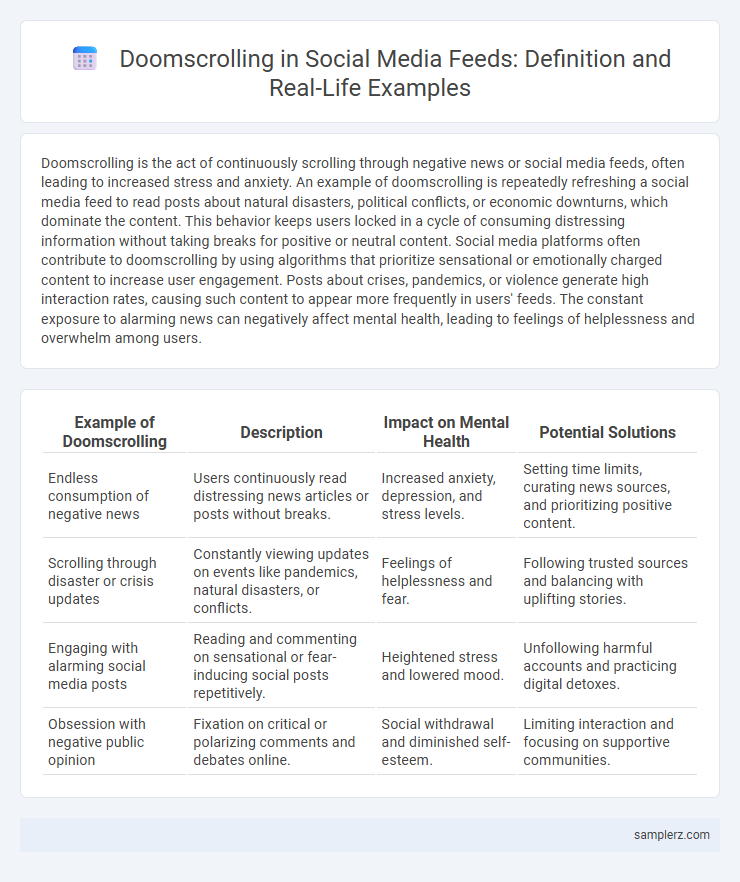Doomscrolling is the act of continuously scrolling through negative news or social media feeds, often leading to increased stress and anxiety. An example of doomscrolling is repeatedly refreshing a social media feed to read posts about natural disasters, political conflicts, or economic downturns, which dominate the content. This behavior keeps users locked in a cycle of consuming distressing information without taking breaks for positive or neutral content. Social media platforms often contribute to doomscrolling by using algorithms that prioritize sensational or emotionally charged content to increase user engagement. Posts about crises, pandemics, or violence generate high interaction rates, causing such content to appear more frequently in users' feeds. The constant exposure to alarming news can negatively affect mental health, leading to feelings of helplessness and overwhelm among users.
Table of Comparison
| Example of Doomscrolling | Description | Impact on Mental Health | Potential Solutions |
|---|---|---|---|
| Endless consumption of negative news | Users continuously read distressing news articles or posts without breaks. | Increased anxiety, depression, and stress levels. | Setting time limits, curating news sources, and prioritizing positive content. |
| Scrolling through disaster or crisis updates | Constantly viewing updates on events like pandemics, natural disasters, or conflicts. | Feelings of helplessness and fear. | Following trusted sources and balancing with uplifting stories. |
| Engaging with alarming social media posts | Reading and commenting on sensational or fear-inducing social posts repetitively. | Heightened stress and lowered mood. | Unfollowing harmful accounts and practicing digital detoxes. |
| Obsession with negative public opinion | Fixation on critical or polarizing comments and debates online. | Social withdrawal and diminished self-esteem. | Limiting interaction and focusing on supportive communities. |
Real-Life Scenarios of Doomscrolling on Social Media
Scrolling through anxiety-inducing news updates during a pandemic surge exemplifies doomscrolling on social media feeds, where users fixate on negative headlines despite emotional distress. Another common scenario involves repeatedly checking political upheaval or crisis coverage, fueling a cycle of despair and helplessness. Social media algorithms exacerbate this behavior by prioritizing sensational or alarming content, trapping users in prolonged exposure to unsettling material.
Typical Patterns: Doomscrolling Through News Feeds
Doomscrolling typically involves endlessly scrolling through negative news headlines and distressing social media posts, often focusing on crises, disasters, or political turmoil. Users frequently engage in this behavior late at night or during idle moments, repeatedly encountering alarming content that heightens anxiety and stress. This pattern reinforces a cycle where the brain prioritizes negative information, making it difficult to disengage from the feed.
Viral Sensationalism: How Negative Stories Dominate Feeds
Viral sensationalism fuels doomscrolling by flooding social media feeds with emotionally charged negative stories that capture attention and drive engagement. Algorithms prioritize shocking headlines and graphic images, amplifying fear and anxiety among users. This cycle reinforces exposure to distressing content, overshadowing balanced or positive news.
Case Study: Pandemic Doomscrolling on Twitter and Facebook
During the COVID-19 pandemic, users on Twitter and Facebook engaged in doomscrolling by continuously consuming alarming news about infection rates and lockdown measures, intensifying anxiety and stress. A case study revealed that prolonged exposure to negative pandemic-related posts increased symptoms of depression and reduced sleep quality among social media users. Algorithms on these platforms amplified the visibility of distressing content, creating a feedback loop that heightened users' psychological distress.
Doomscrolling During Political Crises: Social Media Examples
Doomscrolling during political crises often manifests as endless feeds of alarming news and conflicting opinions on platforms like Twitter and Facebook, amplifying anxiety and misinformation. Hashtags related to the crisis trend globally, encouraging users to consume and share distressing content nonstop. This behavior disrupts mental well-being, highlighting the urgent need for digital literacy and mindful consumption during politically turbulent times.
Celebrity Scandals and the Spiral of Doomscrolling
Endless feeds filled with celebrity scandals fuel a spiral of doomscrolling, trapping users in cycles of negative emotions and anxiety. Sensational headlines about famous figures' controversies trigger compulsive scrolling behaviors, reinforcing an obsessive need to stay updated regardless of mental health impact. This feedback loop amplifies stress, diminishing overall well-being as users prioritize scandal consumption over positive engagement.
The Algorithm Trap: Why Your Feed Keeps Getting Darker
Doomscrolling occurs when social media algorithms prioritize negative or sensational content to maximize engagement, causing users' feeds to become increasingly darker and more distressing. This algorithm trap exploits psychological tendencies by surfacing alarming news and emotionally charged posts, reinforcing anxiety and negativity. As a result, users find themselves caught in a cycle of consuming harmful content, which can adversely affect mental health over time.
User Habits: Nighttime Doomscrolling Behaviors
Nighttime doomscrolling often involves users endlessly scrolling through distressing news or social media feeds before bed, leading to increased anxiety and disrupted sleep patterns. Studies reveal that exposure to negative content during late hours activates stress responses, making it harder for users to relax and fall asleep. Habitual engagement in nighttime doomscrolling can negatively impact mental health by reinforcing negative thought cycles and diminishing overall well-being.
Youth and Doomscrolling: Trends Among Teens Online
Teens increasingly engage in doomscrolling, continuously consuming negative news and social media content that amplifies anxiety and depression. Research shows that over 60% of teenagers report feeling overwhelmed by disturbing posts during their daily feed scrolls. This trend highlights the need for digital literacy and mental health awareness programs targeting youth online behavior.
Coping Strategies: Breaking the Doomscrolling Cycle in Your Feed
Limiting screen time and setting specific intervals for social media use help disrupt the compulsive habit of doomscrolling. Engaging in mindful activities such as deep breathing exercises or offline hobbies redirects attention away from negative feeds. Curating your feed to include positive, uplifting content fosters a healthier digital environment and reduces anxiety.

example of doomscrolling in feed Infographic
 samplerz.com
samplerz.com